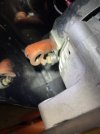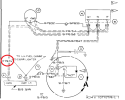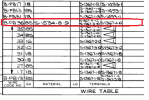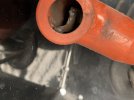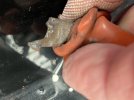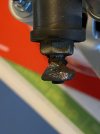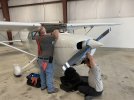- Joined
- May 24, 2016
- Messages
- 961
- Display Name
Display name:
4RNB
C172M, new avionics and engine in past year or two. Alternator replaced before leaving the shop. I still get irregular low volt and amp alarms. Normally goes away within minutes.
A week or two ago my paint shop did a test flight and took a look at this with an avionics company. On the ground the problem seemed to go away, but the avionics guy said that the voltage monitor was on the avionics bus bar and should be switched to the battery bus bar. He had what seemed to be a page from a G3x install manual saying that is where it should go. I spoke to my avionics installer who seemed to not think it was that big of a deal, still willing to take a look at it. Annual appointment set for June.
Yesterday I went out to get current for passengers, had low alarms for a few minutes when at 2300 RPM, increased to 2500 RPM and went away.
Today, the darn thing alarmed the whole flight with my wife on board! Turning AP off did not help. Increasing power did not help. Lights on/off had minimal impact (all LED). Back up G5 did not help when turned off.
I'm the guy that gets so frustrated with these things that at times it could be easy to just sell the darn thing and be done with it...aka bipolar owner. But interested enough to apply to AP school this past week.
So we landed today with low amp readings, volts in the 11s and a message on the GPS/Com that said "Com overtime overtime or under voltage. Reducing transmitter power".
I am now worried about cranking power, want to get the plane somewhere to get examined. Perhaps a second shop? Perhaps all my avionics are just overtaxing the alternator and it needs to be upped in size? OR is my battery getting old? Concord RG-25XC 105% capacity when installed 11/20.
I'm willing to fly with irregular alarms, perhaps from oversensitive settings, but the radio alarm was new and concerning. This tells me there legit is another issue to be fixed.
What would you do and what does the troubleshooting also look like?
Kind of tough to plan for a run to Florida or other XC.
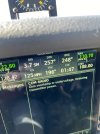

A week or two ago my paint shop did a test flight and took a look at this with an avionics company. On the ground the problem seemed to go away, but the avionics guy said that the voltage monitor was on the avionics bus bar and should be switched to the battery bus bar. He had what seemed to be a page from a G3x install manual saying that is where it should go. I spoke to my avionics installer who seemed to not think it was that big of a deal, still willing to take a look at it. Annual appointment set for June.
Yesterday I went out to get current for passengers, had low alarms for a few minutes when at 2300 RPM, increased to 2500 RPM and went away.
Today, the darn thing alarmed the whole flight with my wife on board! Turning AP off did not help. Increasing power did not help. Lights on/off had minimal impact (all LED). Back up G5 did not help when turned off.
I'm the guy that gets so frustrated with these things that at times it could be easy to just sell the darn thing and be done with it...aka bipolar owner. But interested enough to apply to AP school this past week.
So we landed today with low amp readings, volts in the 11s and a message on the GPS/Com that said "Com overtime overtime or under voltage. Reducing transmitter power".
I am now worried about cranking power, want to get the plane somewhere to get examined. Perhaps a second shop? Perhaps all my avionics are just overtaxing the alternator and it needs to be upped in size? OR is my battery getting old? Concord RG-25XC 105% capacity when installed 11/20.
I'm willing to fly with irregular alarms, perhaps from oversensitive settings, but the radio alarm was new and concerning. This tells me there legit is another issue to be fixed.
What would you do and what does the troubleshooting also look like?
Kind of tough to plan for a run to Florida or other XC.



